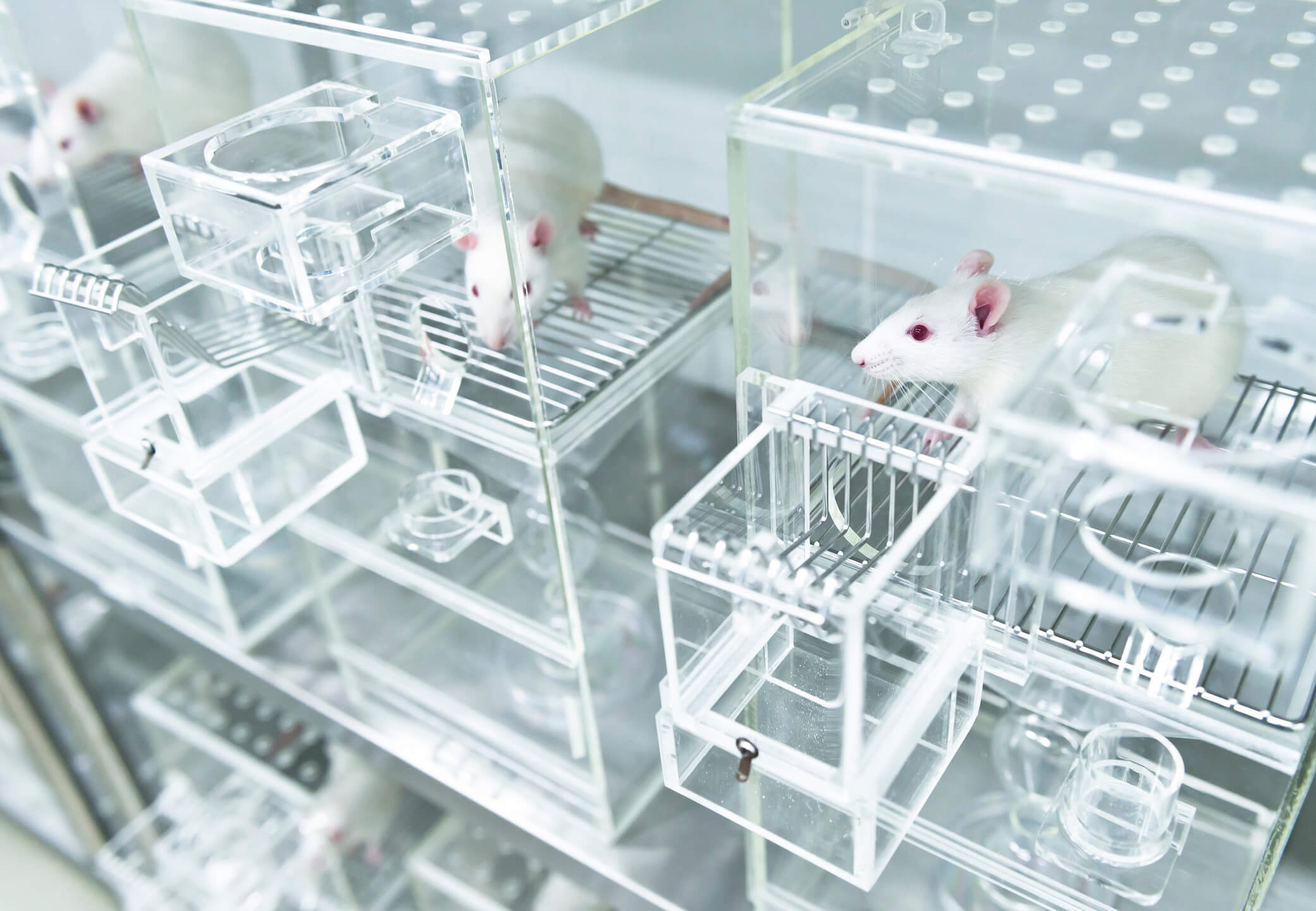The Hidden Impact of Housing: Transparent Reporting Matters
Written by Kati Bertrand, M.S.
June 2024
The accurate and transparent reporting of research methods is among the basic scientific principles that allow investigators to assess, replicate, and build on published research. These principles have also been reported to increase the “reliability, utility, and impact of research.”1 Most scientific publications include methodological information, such as the species used, protocols followed, and statistical analyses performed. This information is so valuable in providing context for studies that manuscripts submitted to peer‐reviewed journals are mandated to include it per each journal’s guidelines to authors (GTA).
However, information regarding the housing conditions to which animals are subjected during a study is usually absent. A 2022 review by Novak et al.2 found that “[of] the guidelines reviewed, 44% of GTAs contained no keywords relating to animal welfare, whereas references to ARRIVE [Animal Research: Reporting of In Vivo Experiments] and the 3Rs were absent in 50% and 34%, respectively. The low emphasis placed on animal welfare and related topics in GTAs may explain the widespread contention that the description of welfare-related topics in published scientific material is inadequate.”
Since 2023, SAO has requested that scientific journals require all manuscripts that discuss procedures involving nonhuman animals include detailed information pertaining to their housing conditions, a standard implemented by the American Journal of Primatology.3 Variations in housing conditions influence animals’ physiology and behavior and subsequently affect the data obtained. To improve transparency, it’s critical that manuscripts include details about those conditions.
In a survey published in Nature,4 researchers found that more than 70% of experimenters were unable to replicate the findings of other scientists and suggest that improving the documentation and reporting on experimental methods—including housing conditions—may help correct the reproducibility crisis.
The ARRIVE guidelines were designed to “ensure transparent and thorough reporting” and enable “readers and reviewers to scrutinize the research adequately, evaluate its methodological rigor, and reproduce the methods or findings.”5 Unfortunately, the 2020 version of ARRIVE excludes animal housing information in its “Essential 10” and only recommends that it be included in manuscripts, despite mounting scientific evidence that differences in housing conditions critically alter scientific results. Introducing that variability contributes to many studies’ lack of reproducibility.
For example, it’s well established that isolating animals from their peers (nonsocial housing) affects their behavior and physiology. Singly housed primates exhibit stereotypic and depression-like behavior.6,7,8,9,10,11,12,13,14,15,16 Additionally, animals housed in isolation have poor welfare outcomes.17,18,19,20,21 Compared to socially housed animals, those housed alone have higher blood pressure,22 higher fecal cortisol and heart rates,23 altered neuroendocrine functions,24 and abnormal immunological functioning.25,26,27,28 A recent meta-analysis found that in rodents, certain housing conditions can increase the morbidity of artificially induced, stress-sensitive conditions, such as cancer, strokes, cardiovascular disease, anxiety, and depression.29
Here are summaries of some journal representatives’ responses to our requests that information on housing be included in manuscripts that discuss procedures involving nonhuman animals:
- Agreed that housing information matters and said they’d keep our advice in mind
- Told us they will take this point into consideration when it comes to reporting standards
- Assured us that they were working on having all papers include details about animals’ housing
- Said they were undertaking a revision of their current policies on publication ethics, which had no specific guidance on animal housing
- Replied that they will require authors to provide more details on the housing of animals in laboratories and would modify instructions to editors about this new requirement
One journal responded as follows:
While we consider ourselves to be ahead of the curve in terms of requesting that authors adhere to the ARRIVE guidelines, we nevertheless acknowledge your concern that the ARRIVE guidelines recommend rather than require detailed description of animal housing. Accordingly, we have decided to include new measures to avoid any misunderstanding of our current requirements for documenting the handling, care, and housing of nonhuman subjects. Specifically, in our manuscript submission form, we will be adding a new question asking the corresponding author to certify that the methods section contains details on the animal species, location of the facility where the study was conducted, and housing conditions.
SAO remains committed to improving publishing standards at scientific journals and reversing the weakening of reporting recommendations like ARRIVE.
Why is this so important? Because a false confidence in experiments on animals is created when reports on them lack critical information that influences whether conclusions drawn from them can be trusted. When other laboratories attempt to reproduce these experiments and get different results, readers are left uncertain about which data to trust and whether the disparate results are due to fundamental flaws in the animal model or to unknown environmental confounds. This confusion impedes the accurate assessment of whether experiments on animals are fit-for-purpose, contributes to the continued use of animals, and delays the replacement of experiments on animals with human-relevant research.
1Simera I, Moher D, Hirst A, et al. Transparent and accurate reporting increases reliability, utility, and impact of your research: reporting guidelines and the EQUATOR Network. BMC Med. 2010;8:24.
2Novak AL, Shaw DJ, Clutton RE. Animal welfare requirements in publishing guidelines. Lab Anim. 2022;56(6):561-575.
3Author guidelines. Am J Primatol. Wiley. Accessed June 11, 2024. https://onlinelibrary.wiley.com/page/journal/10982345/homepage/forauthors.html#_5._EDITORIAL_POLICIES.
4Baker M. 1,500 scientists lift the lid on reproducibility. Nature. 2016;533(7604):452-454.
5Percie du Sert N, Hurst V, Ahluwalia A, et al. The ARRIVE guidelines 2.0: updated guidelines for reporting animal research. BMJ Open Sci. 2020;4(1):e100115.
6Harlow HF, Dodsworth RO, Harlow MK. Total social isolation in monkeys. Proc Natl Acad Sci USA. 1965;54(1):90-7. https://doi.org/10.1073/pnas.54.1.90
7Lutz C, Well A, Novak M. Stereotypic and self-injurious behavior in rhesus macaques: a survey and retrospective analysis of environment and early experience. Am J Primatol. 2003;60(1):1-15.
8Novak MA. Self-injurious behavior in rhesus monkeys: new insights into its etiology, physiology, and treatment. Am J Primatol. 2003;59(1):3-19.
9Gottlieb DH, Capitanio JP, McCowan B. Risk factors for stereotypic behavior and self-biting in rhesus macaques (Macaca mulatta): animal’s history, current environment, and personality. Am J Primatol. 2013;75(10):995-1008.
10Suomi SJ, Harlow HF, Kimball SD. Behavioral effects of prolonged partial social isolation in the rhesus monkey. Psychol Rep. 1971;29(3):1171-1177.
11Anderson JR, Chamove AS. Self-aggression and social aggression in laboratory-reared macaques. J Abnorm Psychol. 1980;89(4):539-550.
12Eaton GG, Kelley ST, Axthelm MK, Iliff-Sizemore SA, Shiigi SM. Psychological well-being in paired adult female rhesus (Macaca mulatta). Am J Primatol. 1994;33(2):89-99.
13Rommeck I, Capitanio JP, Strand SC, McCowan B. Early social experience affects behavioral and physiological responsiveness to stressful conditions in infant rhesus macaques (Macaca mulatta). Am J Primatol. 2011 Jul;73(7):692-701.
14Vandeleest JJ, McCowan B, Capitanio JP. Early rearing interacts with temperament and housing to influence the risk for motor stereotypy in rhesus monkeys (Macaca mulatta). Appl Anim Behav Sci. 2011;132(1-2):81-89.
15Gottlieb DH, Capitanio JP, McCowan B. Risk factors for stereotypic behavior and self-biting in rhesus macaques (Macaca mulatta): animal’s history, current environment, and personality. Am J Primatol. 2013;75(10):995-1008.
16Lutz CK, Davis EB, Ruggiero AM, Suomi SJ. Early predictors of self-biting in socially-housed rhesus macaques (Macaca mulatta). Am J Primatol. 2007;69(5):584-590.
17Harlow HF, Harlow M. Social deprivation in monkeys. Sci Am. 1962;207:136-146.
18Rommeck I, Capitanio JP, Strand SC, McCowan B. Early social experience affects behavioral and physiological responsiveness to stressful conditions in infant rhesus macaques (Macaca mulatta). Am J Primatol. 2011;73(7):692-701.
19Baker KC, Bloomsmith MA, Oettinger B, et al. Benefits of pair housing are consistent across a diverse population of rhesus macaques. Appl Anim Behav Sci. 2012;137(3-4):148-156.
20Gottlieb DH, Maier A, Coleman K. Evaluation of environmental and intrinsic factors that contribute to stereotypic behavior in captive rhesus macaques (Macaca mulatta). Appl Anim Behav Sci. 2015;171:184-191.
21Pinelli CJ, Leri F, Turner PV. Long term physiologic and behavioural effects of housing density and environmental resource provision for adult male and female Sprague Dawley rats. Animals (Basel). 2017;7(6):44.
22Coelho AM Jr, Carey KD, Shade RE. Assessing the effects of social environment on blood pressure and heart rates of baboons. Am J Primatol. 1991;23(4):257-267.
23Doyle LA, Baker KC, Cox LD. Physiological and behavioral effects of social introduction on adult male rhesus macaques. Am J Primatol. 2008;70(6):542-550.
24Cacioppo JT, Cacioppo S, Capitanio JP, Cole SW. The neuroendocrinology of social isolation. Annu Rev Psychol. 2015;66:733-767.
25Lilly AA, Mehlman PT, Higley JD. Trait-like immunological and hematological measures in female rhesus across varied environmental conditions. Am J Primatol. 1999;48(3):197-223.
26Schapiro SJ, Nehete PN, Perlman JE, Sastry KJ. A comparison of cell-mediated immune responses in rhesus macaques housed singly, in pairs, or in groups. Appl Anim Behav Sci. 2000;68(1):67-84.
27Pahar B, Baker KC, Jay AN, et al. Effects of social housing changes on immunity and vaccine-specific immune responses in adolescent male rhesus macaques. Front Immunol. 2020;11:565746.
28Dunphy-Doherty F, O’Mahony SM, Peterson VL, et al. Post-weaning social isolation of rats leads to long-term disruption of the gut microbiota-immune-brain axis. Brain Behav Immun. 2018;68:261-273.
29Cait J, Cait A, Scott RW, Winder CB, Mason GJ. Conventional laboratory housing increases morbidity and mortality in research rodents: results of a meta-analysis. BMC Biol. 2022;20(1):15.


